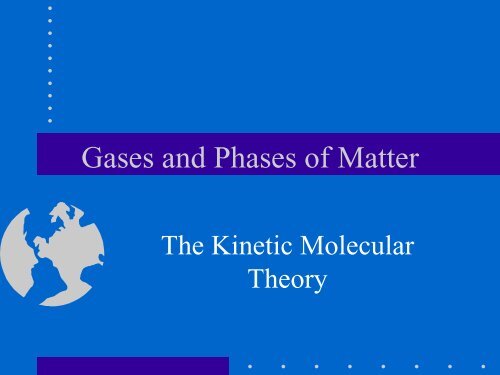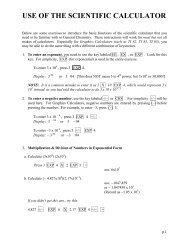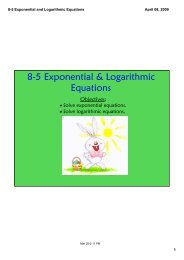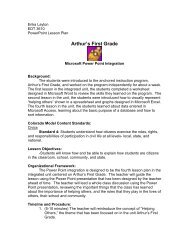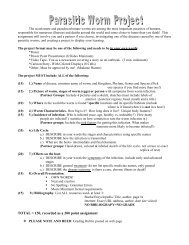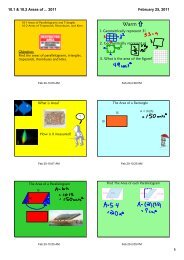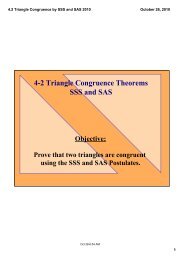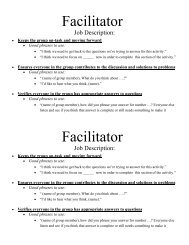Kinetic Molecular Theory PowerPoint
Kinetic Molecular Theory PowerPoint
Kinetic Molecular Theory PowerPoint
Create successful ePaper yourself
Turn your PDF publications into a flip-book with our unique Google optimized e-Paper software.
Gases and Phases of Matter<br />
The <strong>Kinetic</strong> <strong>Molecular</strong><br />
<strong>Theory</strong>
<strong>Kinetic</strong> Means “Moving”<br />
• <strong>Kinetic</strong> = in motion<br />
• <strong>Molecular</strong> = tiny particles<br />
• <strong>Theory</strong> = our best model for how<br />
things actually work
<strong>Kinetic</strong> <strong>Molecular</strong> <strong>Theory</strong><br />
• K<br />
• M<br />
• T<br />
• <strong>Kinetic</strong> energy is perfectly maintained in “elastic”<br />
molecular collisions. I.e., no energy is lost in collisions.<br />
There is no attraction between particles.<br />
• Molecules are in constant Motion.<br />
– Vibrational motion (solid, liquid and gas molecules all<br />
vibrate.)<br />
– Translational motion (molecules free to move past<br />
each other: liquids and gases only.)<br />
• Tiny particles called “molecules” make up all matter.
Evidence That Gases Exist<br />
• Many gases are<br />
invisible, but not all.<br />
• Iodine vapor is pink.<br />
• Chlorine gas is<br />
yellow-green.<br />
• Smoke and clouds or<br />
fog are NOT gases.
Evidence That Gases Exist<br />
• Gases have mass.<br />
• A balloon inflated<br />
with air weighs more<br />
than a non-inflated<br />
one.<br />
• Moving matter can do<br />
work. Moving air can<br />
do work. E. g. wind<br />
farms and tornadoes.
Evidence That Gases Exist<br />
• Many gases are odorless, but others are not.<br />
• E. g. Hydrogen sulfide makes rotten eggs<br />
and sulfur springs smell bad.<br />
• And of course, we have all “passed wind” at<br />
some point (although we usually won’t<br />
admit it.)
Evidence That Gases Exist<br />
• Gases occupy space,<br />
or have volume.<br />
• E. g. the inflated<br />
balloon mentioned<br />
earlier or the air in<br />
your lungs or a<br />
SCUBA tank.
Evidence That Gases Exist<br />
• Gases exert pressure on<br />
surfaces. Gas molecule<br />
collisions put force on<br />
surfaces.<br />
• P = Force/area<br />
• English system = lb/in 2<br />
• Metric system = N/m 2<br />
• 1N/m 2 = 1 Pascal<br />
• You might be astounded<br />
to learn how much force<br />
(pounds) the atmosphere<br />
around you puts on your<br />
body. Try to find out the<br />
total force on your skin<br />
surface.<br />
• Body Surface Area
Evidence That Gases Exist<br />
• Finally, a scientist named Brown discovered<br />
Brownian Motion.<br />
• When smoke particles in a closed chamber<br />
are examined under a microscope, they are<br />
seen to vibrate.<br />
• The explanation for their random movement<br />
is that the particles are constantly<br />
bombarded by moving air molecules.<br />
• Java applet for Brownian motion.
<strong>Kinetic</strong> <strong>Molecular</strong> <strong>Theory</strong><br />
• An “ideal gas” is one in which molecular<br />
collisions are perfectly elastic.<br />
• Experimentation shows us that real gases do<br />
not follow ideal behavior.<br />
• We believe that the assumption that<br />
molecular collisions are elastic is NOT<br />
correct.
<strong>Kinetic</strong> <strong>Molecular</strong> <strong>Theory</strong><br />
• Hence, there are NO IDEAL GASES.<br />
• In real gases, the molecules have some volume of<br />
their own, and there is always some degree of<br />
attraction between molecules.<br />
• Small, non-polar molecules (e. g. He) at very low<br />
pressure and high temperature approach ideal<br />
behavior, but there is still deviation.<br />
• This little applet shows how molecules might<br />
behave and change state with attraction between<br />
the particles. Phase changes with attraction between molecules.
The Gas Laws<br />
• There are several important laws you will<br />
need to know regarding gases.<br />
• These laws involve the use of several<br />
common variables.<br />
• The main variables you will need are these:<br />
– V, P, T, n, R, d and μ (Greek letter “mu”.)
Variables and Their Units<br />
• V = volume in Liters<br />
• T = temperature in Kelvins (°C + 273)<br />
• P = pressure in atmospheres (atm), mmHg, or<br />
kilopascals (kPa)<br />
• n = number of moles of gas<br />
• R = universal gas constant<br />
• d = gas density in g/L<br />
• μ = molar mass of the gas in g/mol
Boyle’s Law<br />
• Robert Boyle discovered that (at constant temperature)<br />
volume and pressure of a gas are inversely proportional.<br />
• V 1 P 1 = V 2 P 2<br />
• Simply put, as P↑, V↓ and vice versa.<br />
• Can the volume of the gas be squeezed down to zero?<br />
• No. The gas is composed of molecules and will always<br />
have some volume and mass.<br />
• As a large volume of atmospheric air is confined to the<br />
small volume of a SCUBA tank, P increases inside the<br />
tank. As V ↓, P ↑.
Charles’ Law<br />
• Jacques Charles discovered that (at constant<br />
pressure) gas volume and temperature are directly<br />
proportional.<br />
• V 1 /T 1 = V 2 /T 2<br />
• Simply put, gases expand as they get warmer and<br />
contract as they cool.<br />
• As T↑, V ↑<br />
• This is how hot air ballooning works.
Gay-Lussac’s Law<br />
• Gay-Lussac discovered that (at constant<br />
volume,) gas temperature and pressure are<br />
directly proportional.<br />
• P 1 /T 1 = P 2 /T 2<br />
• Simply put, as T↑, P↑<br />
• This is why aerosol cans say, “DO NOT<br />
INCINERATE!”
The Combined Gas Law<br />
• To simplify life a bit, Boyle’s, Charles’ and<br />
Gay-Lussac’s Laws are all put together into<br />
one mathematical expression called the<br />
Combined Gas Law.<br />
• V 1 P 1 = V 2 P 2<br />
T 1 T 2<br />
• This is a very important law for you to<br />
know.
Avogadro’s Principle<br />
• Amedeo Avogadro proposed that at equal<br />
temperature and pressure, equal volumes of<br />
all gases contain the same number of<br />
molecules.<br />
• This important idea lead to the discovery of<br />
Avogadro’s famous number (N). There are<br />
6.02 x 10 23 molecules in 1 mole of any<br />
substance.<br />
• In a practical sense, more moles = more V<br />
of gas.
The Ideal Gas Law<br />
• One factor not considered by the combined<br />
gas law is the amount (moles) of gas.<br />
• The ideal gas law takes moles into account.<br />
• PV = nRT<br />
• This equation makes an automatic<br />
correction to standard temperature and<br />
pressure. This allows us to easily work<br />
with systems that are not at STP.
Ideal Gases<br />
• Earlier, we said that there were NO ideal gases.<br />
So, what good is an ideal gas law?<br />
• We can actually make pretty CLOSE predictions<br />
using PV = nRT.<br />
• Johannes Van der Waal developed a modified<br />
version of the equation to compensate for real gas<br />
behavior. You may research van der Waal’s<br />
equation if you wish.
The Universal Gas Constant<br />
• R is the universal gas constant that corrects<br />
for systems not at STP.<br />
• The value of R varies depending on which<br />
units of pressure are being used.<br />
• R = 0.0821 L • atm/mol • K<br />
• R = 62.4 L • mmHg/mol • K<br />
• R = 8.31 L • kPa/mol • K
V, P, T and n<br />
• It is pointless to discuss the volume of a gas<br />
without discussing the moles of gas and the<br />
temperature and pressure at the same time.<br />
• An change in any one of these 4 variables<br />
affects the others. They are all interrelated.
Dalton’s Law<br />
• Dalton’s Law of Partial Pressures says that<br />
in a mixture of gases, each gas exerts its<br />
own pressure as though the others were not<br />
there.<br />
• Mathematically, P T = P 1 + P 2 + P 3 + ...
The “Litter Box” Equation<br />
• A useful version of the Ideal Gas Law<br />
involves molar mass and gas density.<br />
• μ = dRT/P<br />
• If gas density (d in g/L) is known, molar<br />
mass (μ in g/mol) can easily be calculated.<br />
• We call it the “litter box” equation because<br />
a kitty says “mu”, takes a “P”, and kicks<br />
“dRT” over it. Easy to remember.
Barometers<br />
• The barometer is a device<br />
we use for measuring<br />
atmospheric air pressure.<br />
• It consists of a tube that is<br />
sealed at one end and open<br />
at the other.<br />
• The tube is filled with<br />
liquid mercury, tipped<br />
upside down and the open<br />
end placed in a dish of<br />
mercury.
Barometers<br />
Torricellian<br />
Vacuum<br />
Air<br />
Glass Tube<br />
Hg<br />
760<br />
mm<br />
• Gravity pulls the mercury down<br />
slightly in the tube, creating a<br />
vacuum in the top, sealed end<br />
of the tube.<br />
• However, air pressure pushing<br />
on the surface of the mercury in<br />
the dish keeps the mercury<br />
suspended in the tube.<br />
• The higher the air pressure, the<br />
higher the column in the tube.<br />
• On a normal day at sea level,<br />
the height of the mercury will<br />
be 760mm above the level of<br />
the mercury in the dish.
A Rising Barometer<br />
• The next time the weather<br />
forecaster says the barometer is<br />
at 29.32 inches and rising, they<br />
mean the mercury column is<br />
going up in the tube.<br />
• This indicates that the air<br />
pressure is increasing.<br />
• High pressure is usually<br />
associated with cool, dry air and<br />
sunny skies.<br />
• Go ahead with your picnic<br />
plans.
A Falling Barometer<br />
• A falling barometer gets broken!<br />
Just kidding.<br />
• A falling barometer indicates low<br />
air pressure. Air near the ground is<br />
rising into the upper atmosphere.<br />
• Air from near the ground usually<br />
contains moisture (humidity). As<br />
the air rises, it cools and the<br />
moisture condenses.<br />
• The result is clouds and perhaps<br />
rain or snow.<br />
• A falling barometer often indicates<br />
stormy weather. You may want to<br />
change your picnic plans.
Review<br />
V<br />
o<br />
l<br />
u<br />
m<br />
e<br />
B<br />
D<br />
A<br />
C<br />
• Which line on the<br />
graph at the left best<br />
illustrates Boyle’s<br />
Law of pressure and<br />
volume?<br />
• If you said “D”, you<br />
are correct!<br />
Pressure
Review<br />
V<br />
o<br />
l<br />
u<br />
m<br />
e<br />
B<br />
D<br />
A<br />
C<br />
• Which line on the<br />
graph shows Charles’<br />
Law, the relationship<br />
between temperature<br />
and volume?<br />
• If you said “A” you<br />
are correct.<br />
Temperature
Review<br />
P<br />
r<br />
e<br />
s<br />
s<br />
u<br />
r<br />
e<br />
B<br />
D<br />
A<br />
C<br />
• Which line best<br />
illustrates Gay-<br />
Lussac’s law of<br />
pressure vs.<br />
temperature?<br />
• If you said “A” again,<br />
you are correct.<br />
Temperature
Review<br />
V<br />
o<br />
l<br />
u<br />
m<br />
e<br />
B<br />
D<br />
A<br />
C<br />
• Which line best shows<br />
Avogadro’s principle<br />
involving moles of gas<br />
and volume.<br />
• Once again, “A” is the<br />
best answer.<br />
• How did you do?<br />
Moles


